NATSUME SSEKI
Sanshir: a Novel
With an Introduction by HARUKI MURAKAMI
Translated with Notes JAY RUBIN
PENGUIN BOOKS
PENGUIN CLASSICS
Published by the Penguin Group
Penguin Books Ltd, 80 Strand, London WC2R 0RL , England
Penguin Group (USA) Inc., 375 Hudson Street, New York, New York 10014, USA
Penguin Group (Canada), 90 Eglinton Avenue East, Suite 700, Toronto, Ontario, Canada M4P 2Y3
(a division of Pearson Penguin Canada Inc.)
Penguin Ireland, 25 St Stephens Green, Dublin 2, Ireland
(a division of Penguin Books Ltd)
Penguin Group (Australia), 250 Camberwell Road, Camberwell, Victoria 3124, Australia
(a division of Pearson Australia Group Pty Ltd)
Penguin Books India Pvt Ltd, 11 Community Centre, Panchsheel Park, New Delhi 110 017, India
Penguin Group (NZ), 67 Apollo Drive, Rosedale, North Shore 0632, New Zealand
(a division of Pearson New Zealand Ltd)
Penguin Books (South Africa) (Pty) Ltd, 24 Sturdee Avenue, Rosebank, Johannesburg 2196, South Africa
Penguin Books Ltd, Registered Offices: 80 Strand, London WC2R 0RL , England
www.penguin.com
First published 19089
This translation first published in Penguin Classics 2009
Translation, Chronology, Further Reading and Notes copyright Jay Rubin, 2009
Introduction copyright Haruki Murakami, 2009
All rights reserved
The moral right of the translator and introducer has been asserted
Except in the United States of America, this book is sold subject
to the condition that it shall not, by way of trade or otherwise, be lent,
re-sold, hired out, or otherwise circulated without the publishers
prior consent in any form of binding or cover other than that in
which it is published and without a similar condition including this
condition being imposed on the subsequent purchaser
ISBN: 9781101488225
PENGUIN  CLASSICS
CLASSICS
SANSHIR
NATSUME SSEKI (in the Japanese order, surname first) is universally recognized to be Japans greatest modern novelist. Born Natsume Kinnosuke in Edo in 1867, the year before the city was renamed Tokyo, he survived a lonely childhood, being traded between foster and biological parents, was deeply schooled in both the Chinese classics and English, and at the age of twenty-two chose from a Chinese source the defiantly playful pen name Sseki (Garglestone) to signify his sense of his own eccentricity. In 1893, Sseki became the second graduate of (Tokyo) Imperial Universitys English Department and entered the graduate program, but in 1895 he abruptly took a position teaching English in a rural middle school. Though hoping to become a writer as early as the age of fourteen, Sseki chose the more respectable path of English literature scholar, was sent to London by the Ministry of Education in 1900 for two years, and taught in his alma mater until 1907, when his early success as a part-time writer of stories and novels led him to accept a position as staff novelist for the Asahi Shinbun newspaper, in which he serialized the rest of his fourteen novels. Sseki also published substantial works of literary theory and history (and contemplative essays, memoirs, lectures on the individual and society, etc.) and continued to think of himself as a scholar after his controversial resignation from the University. His works quickly lost any hint of academic artifice, however, relying initially on a freewheeling sense of humor, and then darkening as Sseki wrestled with increasingly debilitating bouts of depression and illness. Sanshir, his seventh novel, written in 1908, was the last in which the humor predominated. Sseki wrote many Chinese poems and haiku as a form of escape from the stresses of the world he had created. He died in 1916 with his lastand longestnovel still unfinished. Each new generation of Japanese readers rediscovers Sseki, and Western readers find in him a modern intellect doing battle in familiar territory, a truly original voice among those artists of the world who have most fully grasped the modern experience.
HARUKI MURAKAMI (in Western order) has written twelve novels, eight volumes of short stories, and over thirty books of nonfiction, while also translating well over thirty volumes of American fiction, poetry and nonfiction since his prizewinning debut in 1979 at the age of thirty. Known in the English-speaking world primarily for his novels A Wild Sheep Chase, Hard-boiled Wonderland and the End of the World, Norwegian Wood, Dance Dance Dance, The Wind-up Bird Chronicle, and Kafka on the Shore, Murakami has also published commentary on the 1995 Tokyo subway sarin gas attack in Underground, written a book of essays on the relationship of long-distance running to his fiction, What I Talk About When I Talk About Running, and edited a book of American, British and Irish fiction, Birthday Stories. His works have been translated into more than forty languages.
J AY RUBIN has translated Natsume Ssekis novel The Miner, Akutagawa Rynosokes Rashmon and Seventeen Other Stories (Penguin, 2006), and Haruki Murakamis Norwegian Wood, The Wind-up Bird Chronicle, after the quake, and After Dark. He is the author of Injurious to Public Morals: Writers and the Meiji State and Haruki Murakami and the Music of Words, and the editor of Modern Japanese Writers. He began his study of Japanese at the University of Chicago, where he received his Ph.D. in 1970, and taught Japanese literature at the University of Washington and at Harvard University, where he is now an emeritus professor.
Note on Japanese Name Order and Pronunciation
All Japanese names that appear after this page in the book are written in the Japanese order, surname first. The author is known in Japan as Natsume Sseki, and the writer of the Introduction as Murakami Haruki. Sseki, however, is a traditional pen name (much like that of the seventeenth-century haiku poet, Matsuo Bash), and it is by this, rather than the family name, that most Japanese and Western readers refer to the author. Ssekis name has been given in the Japanese order but Murakamis in the Western order on the cover and title page because of their greater familiarity in the West and for convenience in cataloging.
Some guidelines to pronouncing Japanese names and terms:
All as are long, as in father, e is pronounced as in bed, i sounds like ee, and three-syllable names tend to have a stress on the first syllable. Thus, Natsume is pronounced NAH-tsoo-meh (three syllables) and Sanshir is pronounced SAHN-she-row. Yojir sounds like YO-jee-row. Mineko is MEE-neh-ko. Hirota has a very slight stress in the middle: Hee-ROW-tah.
Macrons have been included to indicate long syllables but have been eliminated from the place names Tky, Kyto, saka, Kbe, Honsh, and Kysh, and from familiar words such as shji and Shint.
Chronology
1854 February: Commodore Matthew Perry returns to Japan with gunboats to enforce previous years demand from U.S. President Fillmore that Japan open its doors to trade. Tokugawa regime of warrior-bureaucrats, headquartered in city of Edo, agrees in writing to open the country, political unrest increases.
1854 or 1855 : Widower with two daughters, Natsume Koh Naokatsu (181797), an Edo nanushi (landowning merchant-class headman with local administrative and police powers), marries Fukuda Chie (182681), divorced daughter of a pawnbroker. Chie will give Naokatsu six more children between 1856 and 1867.
1867 9 February: Chie gives birth to her sixth child on day designated by astrological charts as Elder Brother of Metal, which dooms the child to a life of thievery unless he is given a name with the character for metal/gold/money (


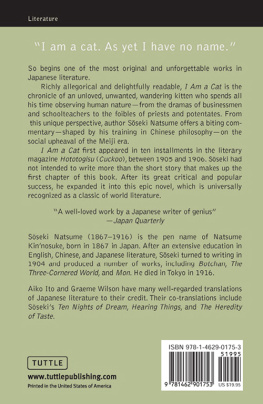
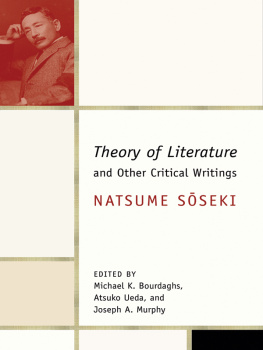
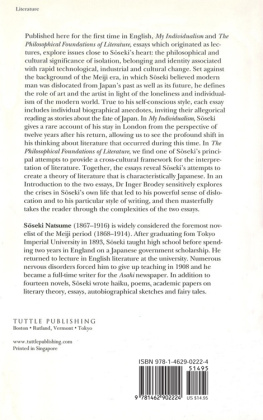
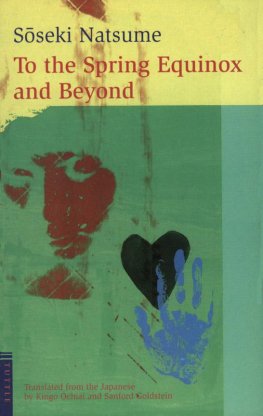
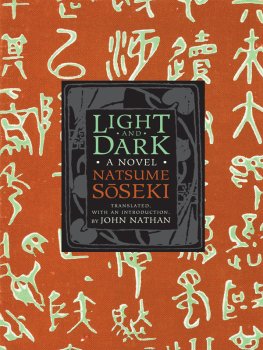

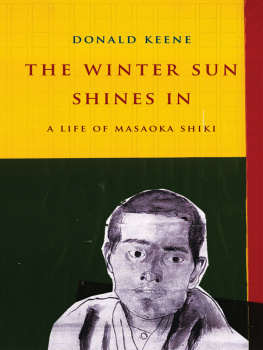
 CLASSICS
CLASSICS